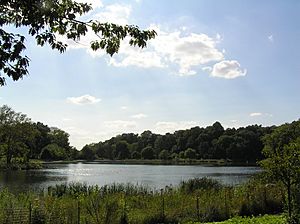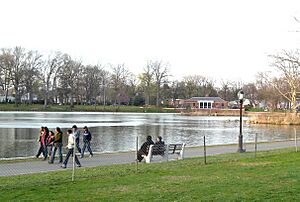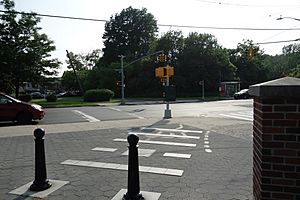Kissena Park facts for kids
Quick facts for kids Kissena Park |
|
|---|---|

A view from the eastern end of the park overlooking the largest aspect of the park, the pond.
|
|
| Type | Public park |
| Location | Flushing, New York |
| Area | 234.762 acres (95.005 ha) |
| Operated by | New York City Department of Parks and Recreation |
Kissena Park is a large park in Flushing, Queens, New York City. It covers about 235 acres (95 hectares). The park is built over the underground Kissena Creek, which flows into the Flushing River. Kissena Park is surrounded by Kissena Boulevard to the west and Fresh Meadow Lane to the east. Rose, Oak, Underhill, and Lithonia Avenues are to the north, and Booth Memorial Avenue is to the south.
This park has many cool features. You can find New York City's only remaining velodrome (a special track for bicycle racing) here. There's also a lake called Kissena Lake, two memorials for soldiers, and lots of playgrounds and sports fields.
The land for Kissena Park was once part of a tree nursery owned by Samuel Parsons in the late 1800s. Some parts were also used by a Long Island Rail Road line. The lake on Parsons's land was named "Kissena," which means "it is cold" or "cool water" in the Chippewa language. The park later got its name from this lake. After Parsons passed away in 1906, parts of his nursery became part of the park we know today. Sometimes, the name "Kissena Park" also refers to the homes just north of the park.
Kissena Park first opened in 1910. In the mid-1950s, it became part of the larger Kissena Corridor Park. Over the years, many improvements have been made. The velodrome was added in 1962, and the lake was cleaned up in 1942 and 1983. The Kissena Velodrome was fixed up and reopened in 2004. A memorial for the Korean War was added in 2007.
Contents
What's in Kissena Park?
Kissena Park is bordered by Booth Memorial Avenue to the south and Kissena Boulevard to the west. Rose, Oak, Underhill, and Lithonia Avenues are to the north, and Fresh Meadows Lane is to the east. The southern part of the park is mostly open grassy areas.
The park has a small lake called Kissena Lake in its northeast corner. This area used to be a wetland, but it was changed into a "bathtub lake" during a renovation in 1942. A freshwater marsh, a wet grassy area, is on the southern side of the lake. The Historic Grove is a 14-acre (5.7-hectare) area on the north side of the park. It has trees from the old nursery that used to be here. Some of these trees are from an old-growth forest that was there even before the park was created.
The Kissena Velodrome is a 400-meter (1,300-foot) track in the middle of the park. It is used for track cycling and is the only bicycle track left in New York City. The velodrome hosts many cycling programs. The rest of the park has playgrounds, soccer fields, tennis courts, and baseball fields.
A memorial for the Korean War is at a northern entrance to Kissena Park, near Parsons Boulevard and Rose Avenue. Another memorial, a large rock with words carved into it, honors World War I soldiers from Queens. It is located on the southern shore of Kissena Lake.
Kissena Park is in the middle of Kissena Corridor Park, which is a long chain of parks. It is also part of the Brooklyn–Queens Greenway, a path for walking and biking. The park corridor follows an old Long Island Rail Road line. A sign remembering this railroad is in the northwest corner of the park. Bike paths connect the park westward to Main Street. The old Long Island Motor Parkway, now a bike path, links Kissena Park to Cunningham Park and Alley Pond Park through the Kissena Corridor.
Why is it called Kissena?
Kissena Park and the nearby Kissena Corridor Park are named after Kissena Lake. The word "Kissena" comes from the Chippewa language. It means "it is cold," "cold place," or "cool water." The Chippewa (also called Ojibwe) Native Americans are not originally from New York. They are from the Midwestern United States. However, the New York area was home to the Canarsee and Rockaway Lenape groups. These groups are related to the Chippewa, as they are all Algonquian peoples.
The name was given to the lake by Samuel Bowne Parsons, a plant expert. He ran a nursery near the lake in the late 1800s. Kissena and Kissena Corridor Parks also share their name with Kissena Boulevard, which runs between them. Kissena Creek, which used to flow through the park, also shares the name. The area of Flushing around the two parks is also sometimes called "Kissena Park."
Park History
How the Land Was Formed
Kissena Park's natural features were shaped by the Wisconsin glaciation about 20,000 years ago. This was a time when large glaciers covered much of the Earth. The glacier covered a lot of Long Island, where Queens is located. As the glacier moved, it created hills and valleys. When the glacier melted and moved back, it left behind several dips in the land. Some of these dips filled with water, creating lakes like Kissena Lake. This process also created a natural source of well water for the area.
Kissena Lake was part of a watercourse called Kissena Creek. This creek used to flow from east to west through what are now Kissena Park and Kissena Corridor Park. The creek started in a swamp in the Kew Gardens Hills and Pomonok areas, south of Kissena Park. It then flowed through the modern Kissena Park, Kissena Corridor Park, and Queens Botanical Garden areas. Finally, it joined Flushing Creek in Flushing Meadows. This system of waterways was mostly a wetland area.
The first people to live in this area were Native Americans. Later, Dutch and English settlers arrived and founded the town of Flushing.
Parsons Nurseries: A Plant Paradise
In 1868, Samuel Parsons opened Parsons Nurseries. This was one of the first businesses to sell plants and trees. Parsons and his team brought exotic trees and shrubs from all over the world to the United States. His advertisements in gardening magazines showed off these unique plants. In the late 1880s, Parsons Nurseries brought 10,000 Japanese maples into the United States each year. They were also the first to bring the California privet plant from Japan to the U.S.
Kissena Lake was first used as a mill pond, which is a pond that powers a mill. Later, Parsons used Kissena Lake for ice cutting. This meant collecting ice from the lake's surface to store and use for cooling before refrigerators existed. In the early 1900s, both Kissena Lake and a nearby swamp were home to wood ducks. There was also a water pumping station near the lake. It was used by different water companies and later by the city.
Samuel Parsons's children, Samuel Bowne Parsons and Robert Bowne Parsons, later took over the nursery. By 1898, Samuel Bowne Parsons's son, George H. Parsons, was in charge. Parsons Nurseries closed in 1901.
Creating the Park
The land for Kissena Park was bought by New York City between 1904 and 1914. After Samuel Bowne Parsons died in 1906, his family sold his nursery land. Real estate developers bought most of it to create a new neighborhood called "Kissena Park." New York City bought the rest of Parsons's land and other plots to create the park. A 14-acre (5.7-hectare) area of Parsons's special trees was saved and is now called the Historic Grove.
In 1907, some developers were accused of dishonest deals. They tried to sell land back to the city for much more than they paid for it. This led to an investigation. The Queens borough president at the time, Joseph Bermel, was also found to be involved. He was accused of lying and taking money for favors. He resigned in April 1908 and left the country before he had to speak in court.
To build the park, the wet marshland that made up most of the area was drained and filled in. Kissena Park officially opened in 1910. A memorial for World War I soldiers was added on the south side of Kissena Lake in 1921. Kissena Park was originally planned to be the main park in Queens, like Central Park in Manhattan. It had beautiful landscaping, a gazebo, and a swimming pool that used lake water, but these were later removed.
Connecting to Kissena Corridor Park
Kissena Park is built on an old 19th-century railroad path. A raised nature trail in Kissena Park was once the main line of the Central Railroad of Long Island. This line ran from Flushing to Bellerose and later to Garden City.
In 1940, New York City decided to buy the old railroad path from Flushing Meadows to Fresh Meadow Road. This land was divided into two parts. The western part, west of Kissena Park, was to become Kissena Corridor Park, connecting Flushing Meadows and Kissena Parks. The eastern part would become the "Cunningham Corridor," connecting Kissena Park to Cunningham Park further southeast. These corridors would have playgrounds, sports fields, trails, and bike paths.
The Kissena Corridor project also included building a large storm sewer. This was needed because the area was a natural drainage basin. In 1942, during World War II, the project was stopped because steel was needed for the war. Work on the sewer project began in 1947.
After the 1939 New York World's Fair ended in 1940, leftover materials from the fair were used to fill in the western part of the future Kissena Corridor. By 1941, the city planned to fill the Kissena Corridor area between Main Street and Kissena Boulevard with garbage. This was seen as a cheaper way to fill the marshlands than using clean dirt. It also helped control mosquitoes in the area. There was already a dump in Kissena Park on Rose Avenue since the 1930s. A second dump in Kissena Park opened in 1943 and closed in 1945.
At the same time, Kissena Lake was cleaned in 1942 as part of a government project. This changed Kissena Lake into a "bathtub lake." Before this, Kissena Lake was part of a wetland, which people in the 20th century thought was not useful land. Later, Parks Department workers cleaned up and organized the tree groves.
In 1951, Robert Moses, a powerful city planner, announced plans to raise the ground level of the western part of Kissena Corridor Park by using it as a temporary garbage dump. However, these plans were stopped due to public opposition. The western part of the Kissena Corridor was eventually filled with dirt from the construction of the Long Island Expressway.
Park Improvements and New Features
The Kissena Velodrome, a 400-meter (1,300-foot) bicycle track, was built in the center of the park in 1962. It was used for the 1964 New York World's Fair and for the U.S. team trials for the 1964 Summer Olympics. It is the only bicycle track left in New York City.
By the 1980s, the park was being used for illegal dumping. Algae grew too much in Kissena Lake, so another cleanup project was done in 1983. A local nature lover named Charlie Emerson started planting a garden in 1986. The garden and a nearby nature center were named after him in 1990.
The Velodrome had become old and worn out. By 2000, efforts began to fix it. In 2003, a $2.3 million project cleaned the lake in stages. The city water was replaced with well water, a system to add air to the water was installed, and the concrete edges were replaced with natural materials like rocks and plants. A small island for birds and turtles was also built in the lake. The Kissena Velodrome was also fixed up and reopened in 2004.
In 2007, the Korean War memorial was revealed at the park's northern entrance. This memorial, designed by William Crozier, honors Korean War veterans from Queens. Its main part is a bronze sculpture called The Anguish of Experience. It shows "a lonely soldier whose face shows the pain of war," followed by five soldiers carrying a stretcher.
Images for kids








